Once you have brought your greyhound home and they are settling into their new life as part of your family, it is important to remember that it can still be a stressful time. Don’t forget to be patient and take it slowly when helping your greyhound feel safe and comfortable in its new surroundings. There is a lots of valuable information in the Pet Greyhound Post Adoption Care Guide. We have also provided you with lots of additional information below to help your greyhound remain happy and healthy happy with some of the common problems being addressed that greyhounds, like many other dogs may encounter throughout their life.
Sleep Startle
‘Sleep startle’ is a term used to describe aggressive behaviour occurring when a dog is woken suddenly. In many ways it makes perfect sense – how do you feel when someone wakes you up unexpectedly?
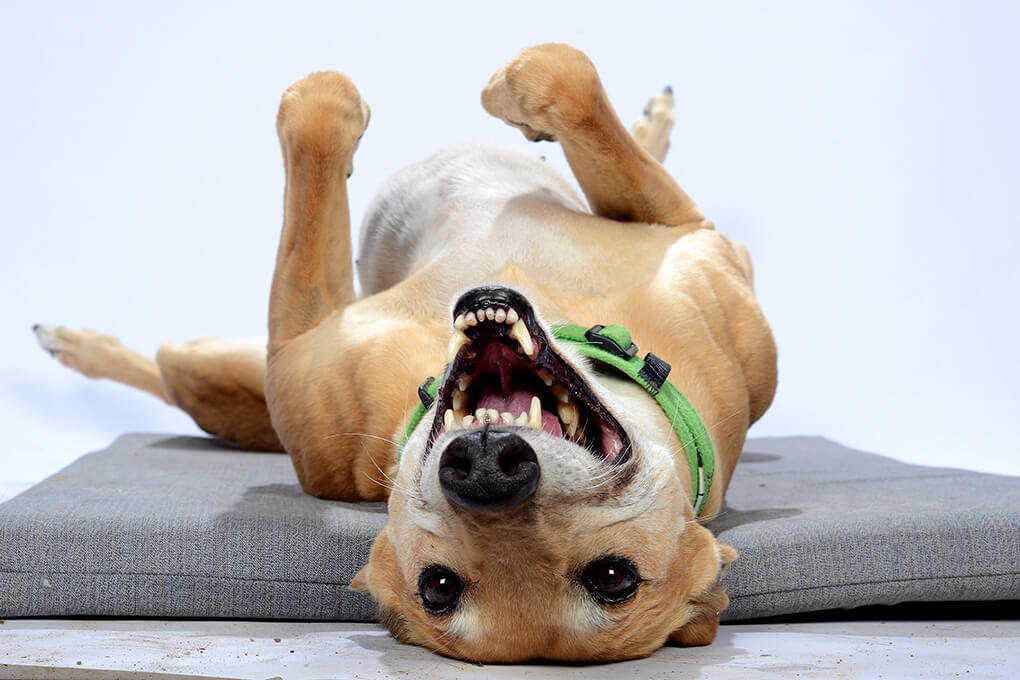
Environmental management
First, it is important to consider the environment where your greyhound is going to sleep, both throughout the day and at night. Here are a few simple guidelines when it comes to preparing their bed:
- Ensure the bed is up against solid walls; three walls are best, but if the layout of your house does not permit that, use two. This will help to make your greyhound feel more secure as no one will be able to creep up behind them.
- Do not place your dog’s bed in the middle of a walkway or thoroughfare.It can be hard for a dog to relax when it is having to contend with constant foot traffic.
- Many dogs will sleep more soundly with an overhead cover.If this sounds like your greyhound, place their bed under a table or give them access to an open soft crate.
- Having some ‘background noise’can be beneficial if your dog is struggling to rest peacefully.
- Some greyhounds benefit from a ‘night light’near their beds overnight, so that they can see well if they wake during the night.
While many people find it tempting to allow their greyhound to share their bed at night; this is not recommended as accidental kicks and prods in the night may result in an unexpected startle response. Give your greyhound their own place to sleep and keep the cuddles to when you are both awake to enjoy them.
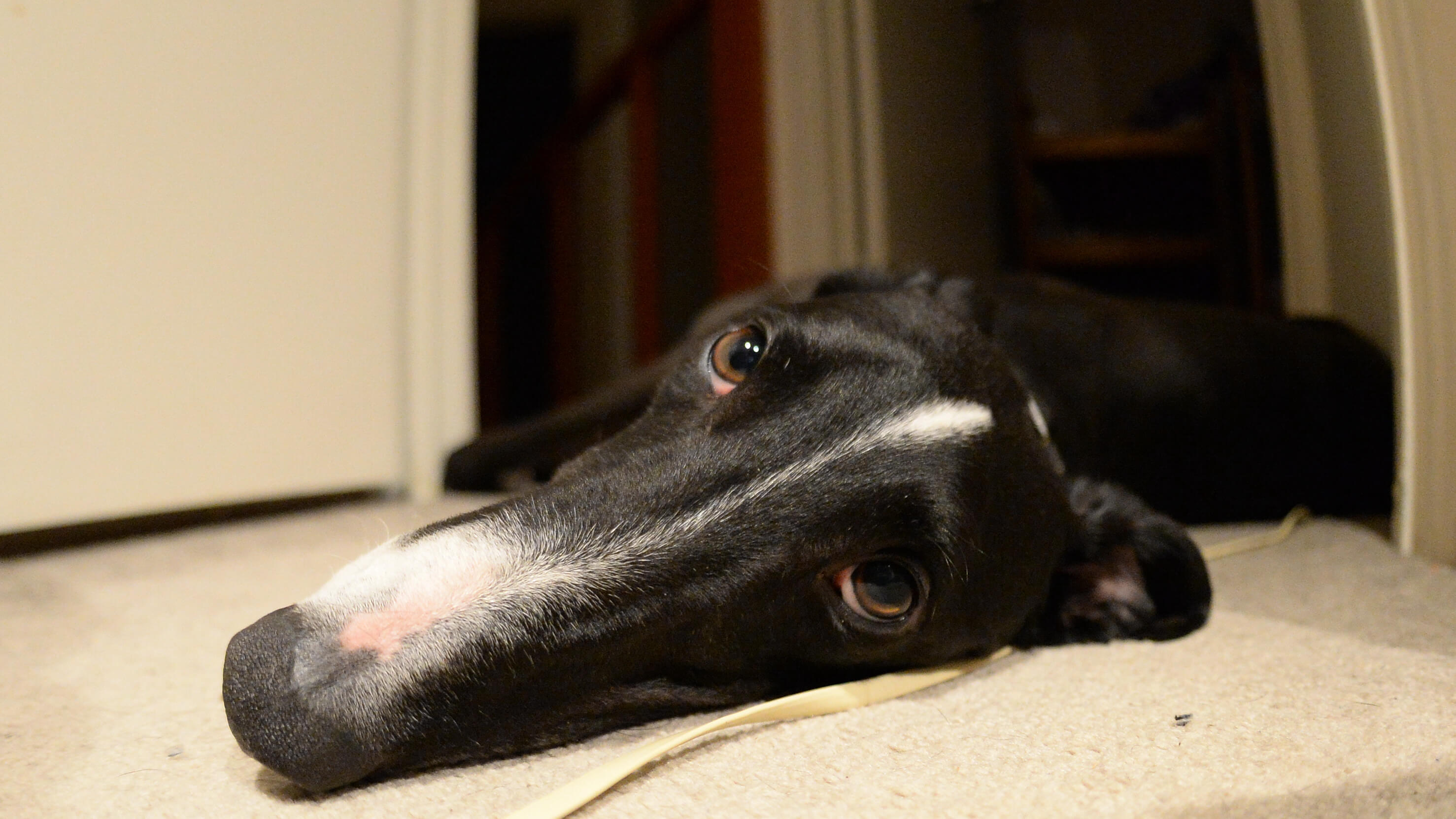
Managing your interactions
In addition to the environment, it is important to manage your interactions with a greyhound who is prone to startle, particularly when they are in their bed. Following these guidelines will help keep both you and your greyhound feeling safe and secure in each other’s company:
- When your greyhound is resting on their bed, it is best to avoid touching them.If you would like to give them a cuddle, wake them up verbally and call them over for some attention. Attention is always better when both parties are on board!
- Decide on a cue that you will use every time you are walking past your dog’s bedsuch as saying, “wake up, I’m coming past”. This will let them know to expect you. It is important that the whole family uses the same cue to increase its predictability.
- If you find that it is difficult to remember to give your dog space while it is on its bed, a line of masking tape one metre in front of the bed can be a useful visual reminder. This is especially beneficial in a home with children, as they are usually in a hurry to get everywhere and a ‘do not cross’ line can help them to remember to follow the rules.
- If your greyhound likes treats, some basic counter-conditioning work can be done as you walk past their bed. Give the ‘wake up, I’m coming past’ cue and toss them a high-value food treat as you pass by.
For most greyhounds, sleep startle is a response to not feeling safe and settled in an environment. If we can set up the environment and manage our interactions consistently with a greyhound to make it feel comfortable, the startle response usually reduces, and everyone can start to feel a bit more relaxed.
Separation Anxiety and Isolation Distress
Before entering the Greyhound Adoption Program, almost all of our greyhounds have lived their lives in the company of other greyhounds. This means that when they are adopted into a home as a pet, it may be the first time they are exposed to being left on their own. It is not surprising then, that it can take some time for a greyhound to become used to their new living arrangements and sometimes they can become distressed and panic when left alone. This experience is extremely unpleasant and dangerous for the greyhound, as they can injure themselves while destroying fences or doors attempting to get access to company or will escape their yard and run through the neighbourhood looking for their family. For many greyhounds, having another dog for company will calm them down and help them feel safe and secure. These greyhounds experience isolation distress and ideally, would live with another compatible dog. Some greyhounds become very reliant on human company to feel safe and will panic if their owners are not with them – this is called separation anxiety.
Before leaving your greyhound at home alone, you should teach them that spending time alone in a safe place is both enjoyable and temporary.
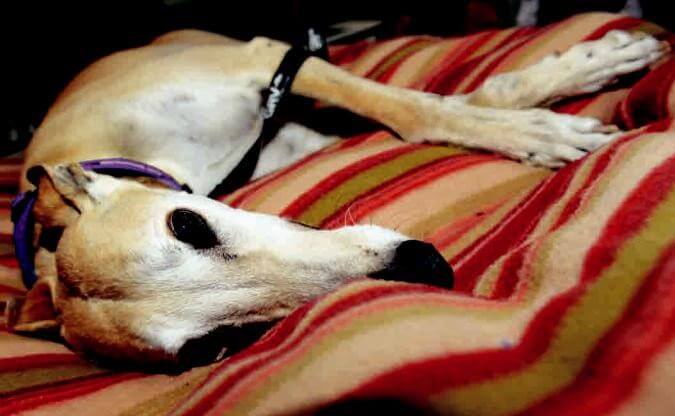
![]()
Start by setting up a secure and comfortable area for your greyhound to settle in. The area should have a resting space that is out of the weather and provides access to clean water, a food bowl, toileting area and activities for your greyhound to do while you are gone. If you are happy for them to have indoor access while you are out, you should ‘puppy proof’ an area for them and set up access to the outside so that they can go outside to the toilet.
![]()
Make sure that lots of great things happen in this area from the moment your greyhound comes home. Think about this area like your greyhound’s very own apartment so that it includes things such as feed time, access to chew toys and food puzzles and time spent relaxing with the family. At the same time, it is important your greyhound feels safe. So, be sure not to crowd them with lots of people coming up and touching them all the time, particularly around their bed – their ‘safe spot’.
![]()
Initially, you should encourage your greyhound to settle in this area while you move in and out of the area without making a big deal about the situation. You might pop out briefly to the kitchen to grab a drink and return, just the way you would with any other family member. If your greyhound jumps up to follow you, take them back to their bed and encourage them to settle there with an activity or chew.
REMEMBER: The aim of this training is to have your greyhound feel completely comfortable while you go about your day, regardless of where you are in the house. As your greyhound gets better at relaxing in their own space, you can start to make your absences longer – go have a shower while your greyhound is closed in their safe space, or pop out to the neighbour’s place for a coffee.
![]()
When you come home, greet your greyhound as you would any other family member (i.e. with a quick hello and a pat) then go about your day again as usual. When your greyhound is settled and calm, then it’s time to have a big lovefest and give them lots of attention and affection.
It is normal for your greyhound to want your attention when you are home, and it will take a little while to adjust to their new routine. During this time, be patient and do your best to help your greyhound understand that there is nothing to be worried about, they are safe, and you will always return to them.
Don’t forget that your greyhound may never have had undivided human attention all day, every day. If so, if you jump up to attend to their every whim from the moment they come home, they are going to both enjoy this and expect it – even when you go back to work or leave to buy more dog treats! This is going to create problems! It is much better to aim to create the same kind of relationship you have with human family members – everybody has their own independent lives and interests, but we rest, eat, and sometimes sleep together.
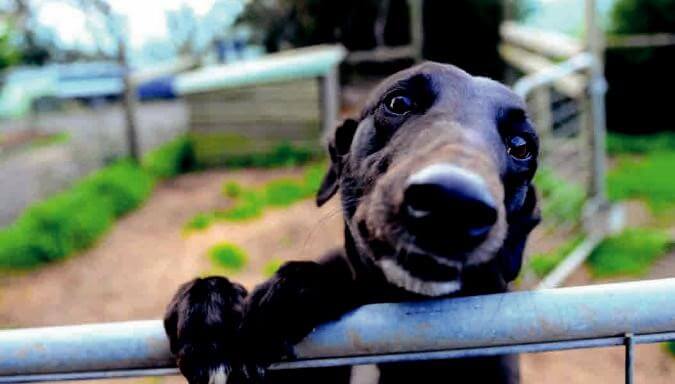
Identifying and managing signs of separation anxiety and isolation distress
Before you decide that your greyhound is becoming stressed when left alone it is it worth considering if there could be another cause for your dog’s distress. For example, if you leave your greyhound in the backyard when you are not around and they are fearful of the noises of a nearby busy road, it could be that if they become distressed in the yard, and they may feel more comfortable when given access to the house. If you are unsure it can be worthwhile to record your dog when they are alone to gather some more information.
![]()
There is a range of strategies you can use to assist with managing signs of separation anxiety or isolation distress:
- take the greyhound out for a walk before you leave so that they have had a chance to toilet and are tired and likely to sleep while you are out;
- don’t engage in long goodbyes as this may distress the greyhound, instead get up and casually leave;
- don’t make your return exciting, just say hello to your greyhound and continue with your tasks; after 5-10 minutes you can calmly greet them in a low-key manner but only when they have settled;
- don’t allow your greyhound to get accustomed to your undivided attention when you are at home; allow them to spend time away from you (i.e. outside) while you are still there and provide them with things to occupy themselves with to make the experience positive and rewarding;
- when you leave your greyhound alone, ensure that they have a full belly, some toys to play with and are warm and dry, with access to a toileting area, so that they are not distressed when you leave;
- some greyhounds showing mild anxiety symptoms may benefit from anti-anxiety treatments – you may want to talk to our GAP behaviour team;
- some dogs seem to benefit from having some ‘white noise’ when left alone, such as a radio playing quietly; this can also help to muffle sudden, unexpected noises that your greyhound may find stressful.
It can also be beneficial to use mealtimes as a separation training exercise. Without shutting your greyhound away, feed them in an area separate from where you will be so that he can have a positive experience while alone. This positive experience can be extended by making the meal take longer and more interesting by using food puzzles and treat dispensing toys. Because the door remains open, your greyhound can make the choice to either remain with their meal or return to the family. They should soon realise that a short separation does not mean you’ll be apart forever!
![]()
There are signs that you may begin to observe in your greyhound that look a bit more serious which mean you may need professional help.
Some of these signs might include:
-
- your greyhound begins to show signs of anxiety before you leave such as pacing, drooling, hypervigilance, trembling, or following you around constantly; remember though, many greyhounds will follow their person around the house without being anxious – they just want to be involved.
- your greyhound panics when you leave, particularly if they are most distressed immediately after you depart. Indicators of this may include:
-
- other interesting stuff on the other side of the fence. Your greyhound may just want whatever is on the other side of the fence!
- attempts to get access to the house through the normal access door, or through windows (e.g. chewing door frames, scratching at doors, throwing themselves in to doors or windows);
- signs of increased arousal such as drooling, increased activity levels, or prolonged vocalisations;
- attempts to escape the yard, such as jumping fences, digging under fences or gates, or pushing through or destroying fence panels. If you see this type of behaviour, check for signs of small animals or other interesting stuff on the other side of the fence. Your greyhound may just want whatever is on the other side of the fence!
If your greyhound is panicking when left alone, you need to seek help from a veterinarian or veterinary behaviourist with experience working with dogs showing separation anxiety. If you are unsure of whether you need to seek professional help with your dog, please call GAP and chat to a member of the behaviour team.
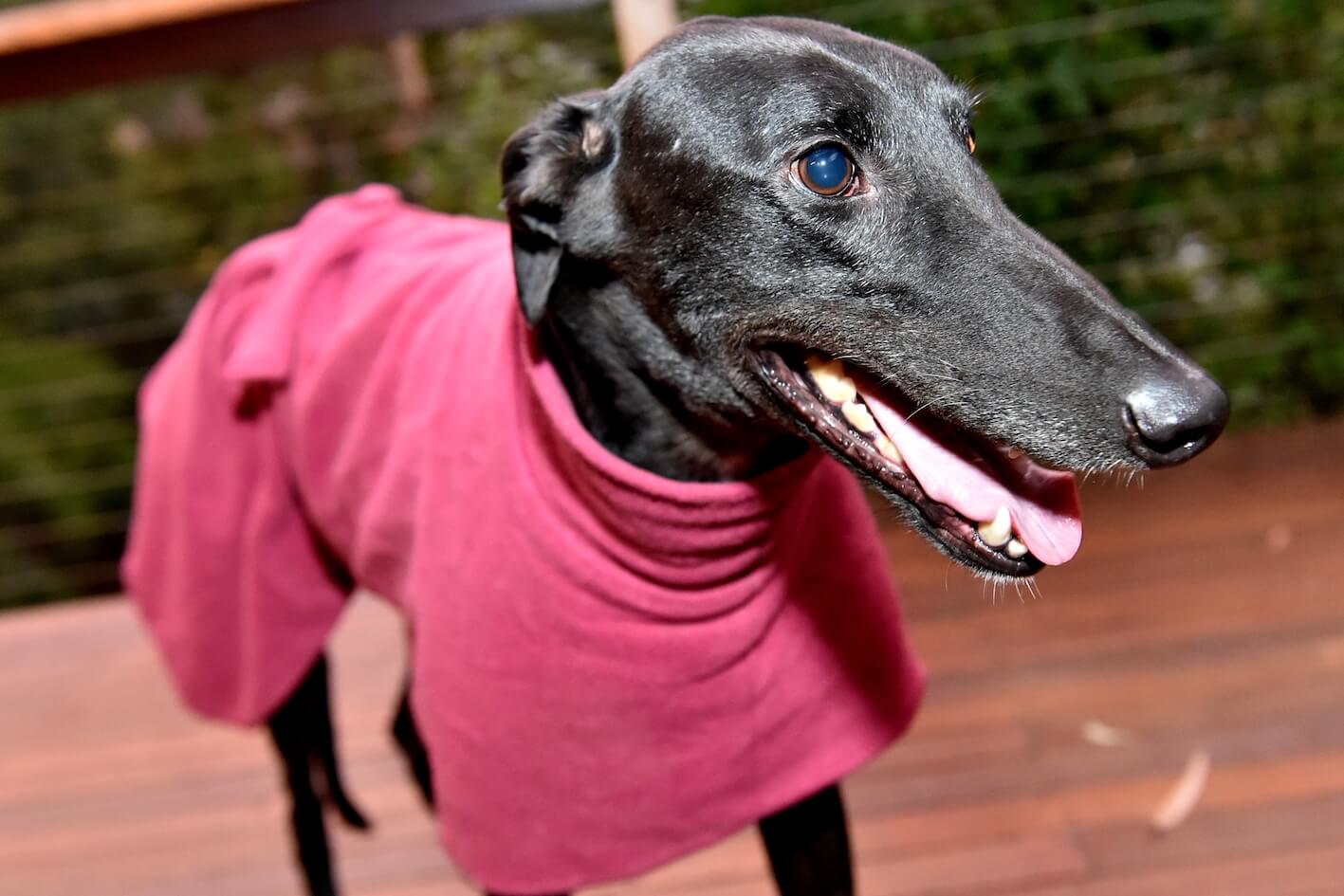
For more information
There is a range of resources out there to help you, but these might provide a good start with lots of great information for helping owners who have dogs that suffer from separation anxiety:
- Malena DeMartini is a leading expert on the treatment of separation anxiety in dogs and has a website at https://malenademartini.com/
- The following books ‘I’ll be home soon’ by Dr Patricia McConnell and ‘Treating Separation Anxiety in Dogs’ by Malena DeMartini
- ANZCVS Contact list for Veterinary Behaviourists


